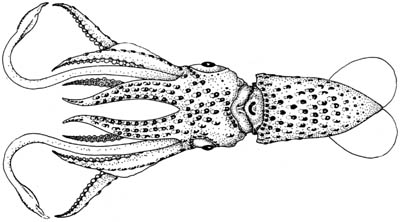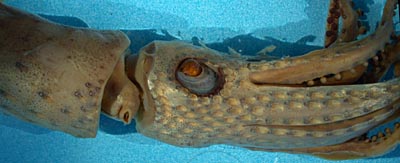Histioteuthis celetaria
Richard E. Young and Michael VecchioneCharacteristics
- Photophores
- Basal Row with 9 photophores and a single sawtooth (see arrow in photograph at right).
 image info
image info Figure. Ventral view of the posterior margin of the head of H. celetaria, 39 mm ML, NMNH specimen, preserved. Photograph by R. Young.
- Club suckers
 image info
image info Figure. Oral view of a club sucker of H. celetaria, ventral series, holotype. Drawing from Voss (1969, Fig.15b).
- Suckers of 3 ventral-marginal rows of manus with broad, asymmetrical outer rings.
- Central suckers of manus only slightly enlarged.
 image info
image info Figure. Oral view of the left tentacular club of H. celetaria, holotype. Drawing from Voss (1969, Fig.15e).
Comments
More details of the description can be found here.Species of the celetaria-group are characterized by:
- Head photophores:
- Type 1b pattern on head.
- Basal Row of head with 9 or 10 photophores.
- Right Basal Series of head absent.
- Arms IV with 3 longitudinal series on arm base (drawing below).
 image info
image info
Figure. Ventral view of right arm IV, holotype, 39 mm ML, female. Drawing from Voss (1969, Fig.15f). - Most species with separate group of 4-8 compound photophores on ends of arms IV (drawing above) (Voss, et al., 1998). Apparently this feature is absent in H. inermis.
- Compound photophores of large, uniform size and evenly spaced on anterior 2/3 of ventral mantle.
- Tubercles
- Absent.
The species differ in the following manner:
| Character | H. celetaria | H. inermis | H. pacifica | H. sp. A |
|---|---|---|---|---|
| Club suckers | ||||
| Asymmetrical outer sucker rings in: | 3 ventral-marginal sucker series | No asymmetrical rings | 2 ventral-marginal sucker series | No asymmetrical rings |
| Size of medial manal suckers: | Slightly larger than marginal suckers | 2 X marginal suckers | 1.5 X marginal suckers | Slightly larger than marginal suckers |
| Large manal-sucker dentition: | 12-13 teeth on distal margin | 20-27 teeth on entire margin | 28-32 teeth on entire margin | 15-20 teeth on distal margin |
| Photophores | ||||
| Single sawtooth in Basal Row photophore pattern: | Yes | No sawtooth | No sawtooth | Yes |
| Number of photophores in Basal Row: | 9 | 10 | 9 | 9 |
With the exception of the analysis of head photophores and the inclusion of H. inermis in this species group, most of the information presented here is from Voss (1969) and Voss, et al . (1998)
Life History
Single mature female (258 mm ML) and male (87 mm ML) known; mature eggs are 1.9 mm in diameter (Voss, et al, 1998). The smallest specimen illustrated is a 10.3 mm subadult. Paralarvae are unknown.
 image info
image infoFigure. Ventral view of young H. celetaria from the stomach of Alepisaurus ferox taken off Madeira, 10.3 mm ML. Drawing from Voss, 1969 (Fig. 15d).
Distribution
Geographical distribution
Type locality:Northwestern Atlantic, 32°10'N,64° 45'W. H. celetaria occupies tropical and subtropical waters of the Atlantic Ocean. However, it appears to be absent from the Gulf of Mexico and the Caribbean Sea (Voss et al., 1998).
References
Voss, N. A. 1969. A monograph of the Cephalopoda of the North Atlantic: The family Histioteuthidae. Bull. Mar. Sci., 19: 713-867.
Voss, N.A., K. N. Nesis, P. G. Rodhouse. 1998. The cephalopod family Histioteuthidae (Oegopsida): Systematics, biology, and biogeography. Smithson. Contr. Zool., 586(2): 293-372.
Title Illustrations
| Scientific Name | Histioteuthis celetaria |
|---|---|
| Location | 32° 10'N, 64° 45'W |
| Reference | from Voss, N. A. 1969. A monograph of the Cephalopoda of the North Atlantic: The family Histioteuthidae. Bull. Mar. Sci. 19:713-867. (fig. 15a) printed with permission |
| Sex | Female |
| Life Cycle Stage | immature |
| View | ventral |
| Size | 39 mm ML |
| Type | holotype |
| Copyright | © 1969 Bulletin of Marine Science |
About This Page
Drawings from Voss (1969) printed with the Permission of the Bulletin of Marine Science.
Richard E. Young
Dept of Oceanography
University of Hawaii
Honolulu, Hawaii 96822
USA
National Marine Fisheries Service
Systematics Laboratory
National Museum of Natural History
Washington, D. C. 20560
USA
Page copyright © 2000 Richard E. Young and
Citing this page:
Young, Richard E. and Vecchione, Michael. 2000. Histioteuthis celetaria . Version 01 January 2000 (under construction). http://tolweb.org/Histioteuthis_celetaria/19798/2000.01.01 in The Tree of Life Web Project, http://tolweb.org/











